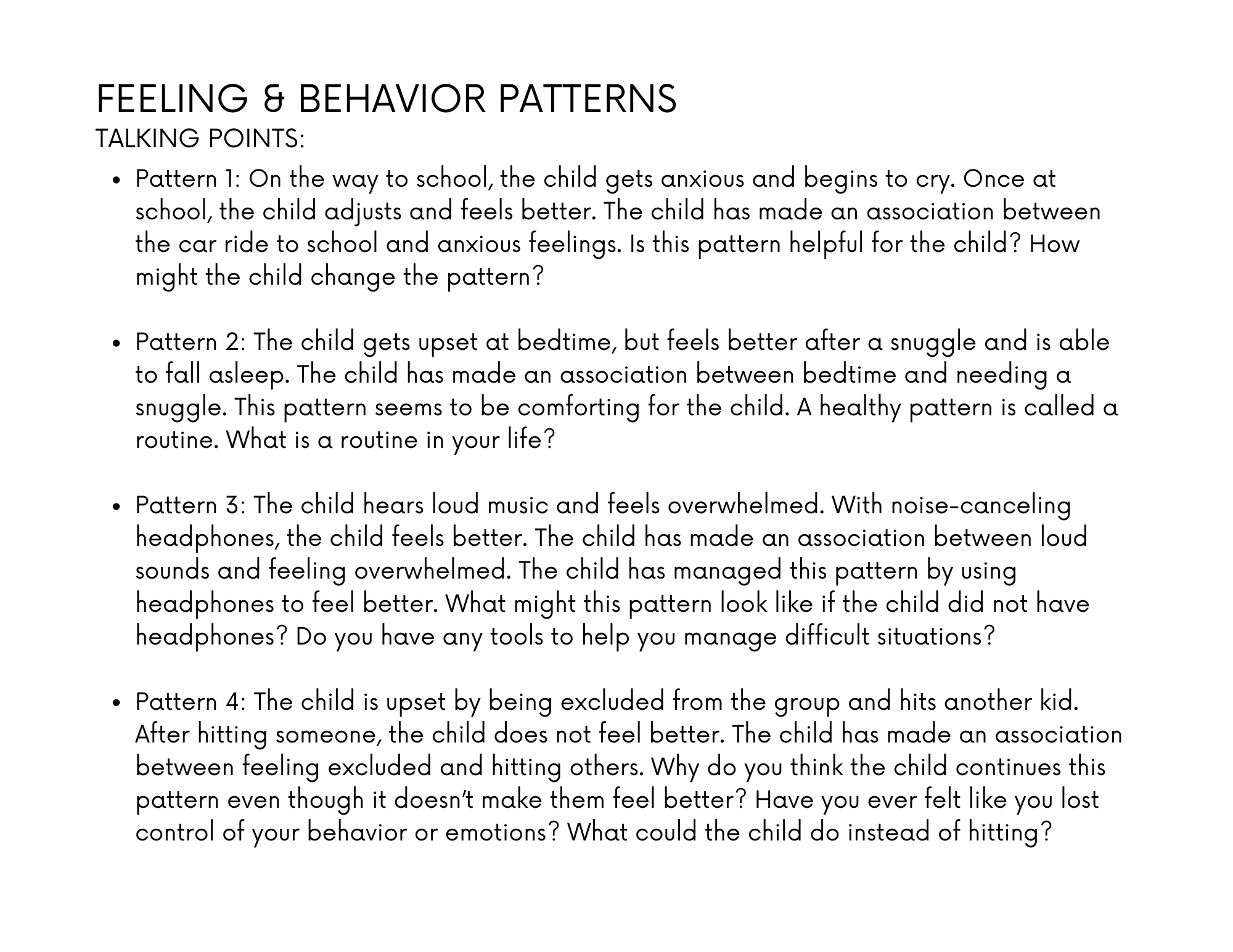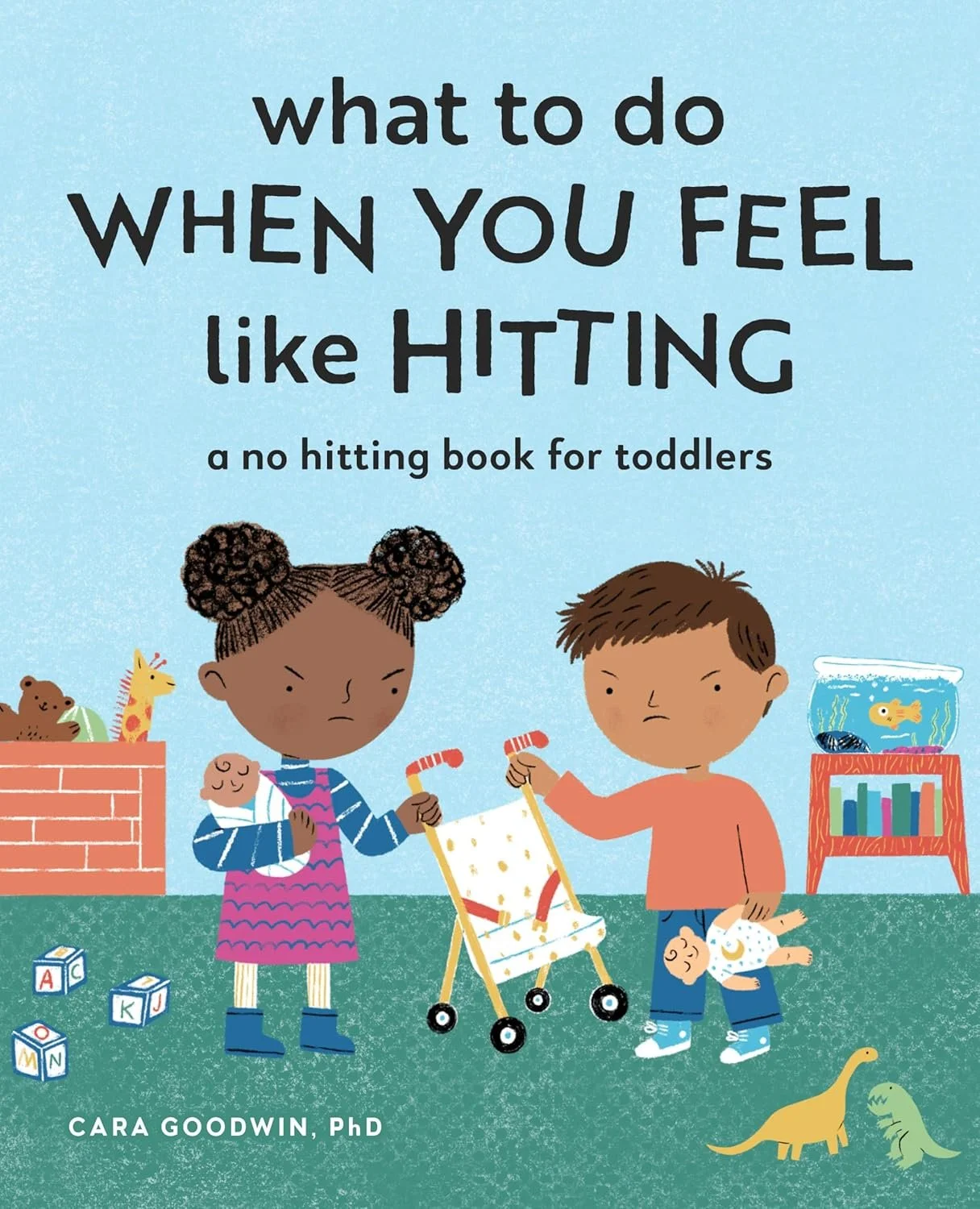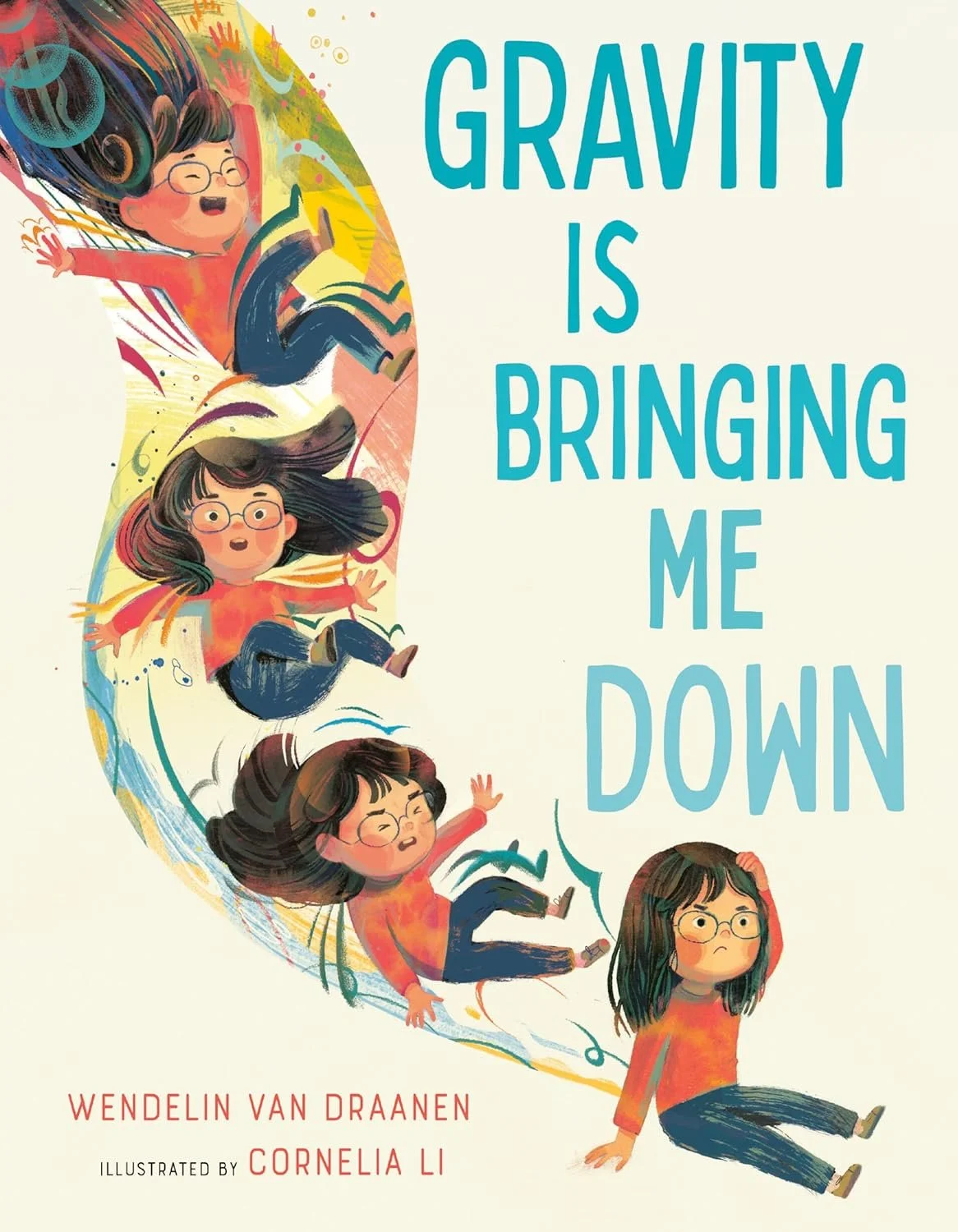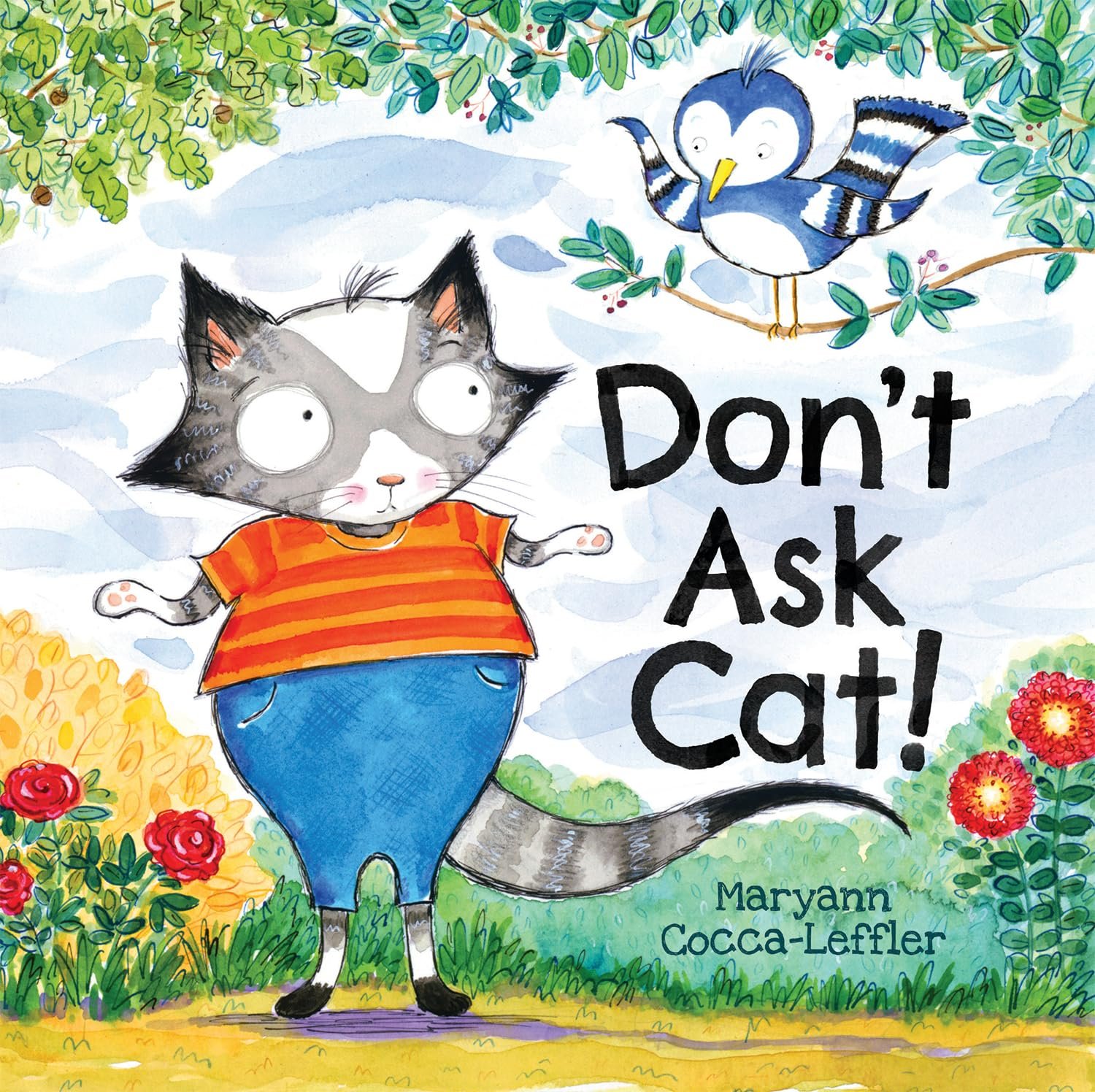Feeling & Behavior Patterns
Learn how to develop adaptive patterns and break free of maladaptive ones.
What is a feeling or behavior pattern?
A feeling or behavior pattern develops when a person has a reoccurring emotional and/or behavioral reaction to a cue. These patterns can be adaptive (a child relaxes when when being read a bedtime story) or maladaptive (a child exhibits escalating anxiety on the way to school). A maladaptive pattern may seem illogical and can cause distress and frustration.
Read on to learn how to interrupt maladaptive patterns and reinforce adaptive ones!
How to Break a Pattern:
Talk About It: Explore familiar and unfamiliar patterns (see below for a free printable guide!).
Problem Solve: Ask kids what advice they would give to someone stuck in a maladaptive pattern. Encourage them to speak from experience and give examples from your own life!
A great way to interrupt a pattern is to identify the cue that triggers a reaction. Once we identify the cue, we can consciously change the way we want to react. This may take time, practice, and patience, so don’t be discouraged if the maladaptive pattern doesn’t resolve immediately.
Sometimes we need a motivator to help use change our reaction to a cue. Motivators can come in many different forms. Here are a few examples:
Intrinsic Motivation through Mindfulness: I notice that I feel better when I am in control of my reactions.
Positive Reinforcement: The positive reaction to a cue generates a favorable stimulus (examples: a sticker on a behavior chart, praise from an adult, a treat).
Negative Reinforcement: The positive reaction to a cue generates the removal of an unfavorable stimulus (examples: a break from chores, no time out, cessation of negative attention).
Make a Plan: How can adaptive patterns help us? Adaptive patterns are sometimes called routines. What kind of routines do we already practice? What kinds do we want to develop? What motivates us?
FREE PRINTABLE GUIDE:
Draw your own! What patterns have you gotten stuck in? How did you break free?
Use beads to visualize patterns and assign different colors to represent emotional and behavioral goals.
Explore our recommended materials for:
Explore cues and reactions with our recommended Books About Behavior:
A book that highlights: behavior, self-discovery, & repair.
“It is not the students. It is not the classroom. It is not the reading or the writing or the math. It is something scribbly, scrunchy, grabby, burpy, and rude. It is the Snurtch. This clever picture book takes a discerning look at the challenges of behaving and controlling your emotions—especially when your own personal monster keeps getting in the way.”
A book that highlights: behavior, flexibility, & repair.
“Benny and Penny hide every toy and tell Cousin Bo he can’t play with them. Will the three mice find a way to play without something getting torn, ripped, or snatched away? Geoffrey Hayes, the uncontested master of children's comics, thrills us with this hilarious tale of tiny cousins who discover a game that can’t ever be ruined.”
A book that highlights: behavior, bullying, & repair.
“Little Tiger is excited to go to school, but he doesn’t always know how to behave. Little Tiger can be quite bossy. If he wants something, he just takes it. His unruly nature intimidates everyone around him. But when his teacher gives him a gentle tip, he realizes that small changes can make a big difference and Little Tiger discovers that treating others well can be fun! Carol Roth tells a sensitive story about a bully who learns to be considerate and yet remains true to himself.”
A book that highlights: behavior, perseverance, resilience, advocacy, & change.
“I Am Somebody takes the reader on a journey over the course of a day, as our main character notices various forms of neglect and injustice—from trash on the sidewalk and students butting in line waiting for the bus, to not sharing on the playground and bullying about food. In each instance, the young child remarks that SOMEBODY should do something to remedy the situation(s) until, eventually, they realize that they are the person that can effect change. This powerful story reminds us that every living thing is unique and should be treated with kindness and respect and that we are ALL “somebody.””
A book that highlights: behavior, empathy, & resilience.
“It's a scenario that is familiar to all parents: you and your child are in a toy store, or walking past an ice cream truck and instantaneously, your child's "want monster" kicks into high gear. Often, giving in only leads to more and more wanting. What to do? The Want Monsters takes a unique and humorous look at how one boy learns how to calm Oskar, his "Want Monster." He says that often Oskar is a fun and lively companion, urging him to push the envelope in all sorts of situations--eating too much ice cream, playing video games until his thumbs fall off, needing to be the center of attention "way too much." But the boy gets tired of the drama and fallout from it, and, after getting some advice from a wise worm, finds a way to tame Oskar without hurting his feelings--or destroying the good and motivating energy that "wanting" can also generate.”
A book that highlights: behavior, anxiety, inclusion, problem solving, & autism spectrum disorder.
“Bitsy is a little bat with big star dreams of making friends at her new school. But when she arrives, Bitsy doesn’t feel like she fits in. The other kids sit on their chairs, but sitting upright makes Bitsy dizzy. The other kids paint with their fingers, but Bitsy would rather use her toes. Everyone tells Bitsy she’s doing things wrong-wrong-wrong, so she tries harder…and ends up having a five-star meltdown. Backmatter includes a More About Autism facts page.”
A book that highlights: lying, friendship, & repair.
“Snake loves art class—until his project is a disaster, and he makes a terrible mistake that hurts a friend. How will Snake fix his mistake? Acclaimed author-artist Sarah Kurpiel’s Snake’s Big Mistake is a picture book about art, friendship, apologizing, and forgiveness.”
A book that highlights: behavior & aggression.
“Toddlers are still learning how to speak, socialize, and understand their emotions. It's common for them to react with their hands when they get frustrated—but hitting is never okay. What to Do When You Feel Like Hitting helps toddlers understand why hitting is not allowed and shows them how to react to their feelings with actions that are safe and kind.”
A book that highlights: behavior, resilience, & flexibility.
“Oliver McSnow ONLY says NO. He says NO so much that his NO starts to grow. And grow and GROW...until that NO is out of control! No baths. No brushing teeth. No cleaning up. No bedtime! Morning, noon, and night—it’s just NO, NO, NOOOOOOOOOO! But then Oliver's cousin visits. Jess loves the word YES. YES to friends! YES to food. YES to fun! YES, YES, YES, YES, YESSSSS! And suddenly, Oliver's world gets opened up in a most wonderful way!”
A book that highlights: behavior, empathy, & resilience.
"When I woke up I was a Hippopotamus! Yawning in the morning, I raised up my sleepy head, then took one look out of the window and got straight back into bed." A little boy transforms into different creatures as his moods change throughout the day, until finally he goes a little too far and discovers his parents have transformed too!”
A book that highlights: behavior, lying, & repair.
“When Llama Llama accidentally breaks Mama Llama's favorite picture frame, he decides to tell a little lie about how it happened. In the end, Llama Llama learns a powerful lesson about telling the truth, even if it's hard to say. Told with Anna Dewdney's signature sweet rhyme, this newest installment of the Llama Llama series is timeless and can be used as a tool to educate readers in social and emotional learning.”
A book that highlights: behavior, bad mood, & resilience.
“Gravity becomes a very personal problem for a girl as she stumbles and tumbles through a long day. A hilarious look at a core science concept for any kid who has ever had a case of the clumsies!
When Leda wakes up by falling out of bed, she knows that gravity is in a very bad mood. Again.
Sure enough, she struggles with stumbles and bumbles at home, trips and blips on the bus, and bashes and crashes in the classroom. But a lesson on gravity helps her understand what’s really going on. And after a visit to a science center, Leda's mood is lifted...just in time for her to tumble-- happily!--into bed.”
A book that highlights: behavior, social skills, & empathy building.
“A cat who struggles with social skills learns ways to be honest without being rude.
Cat always says what's on his mind, no matter how much his words may upset others. But when he hears his friends talk about him, Cat realizes that words can hurt, even though that may not be the intention.”

















